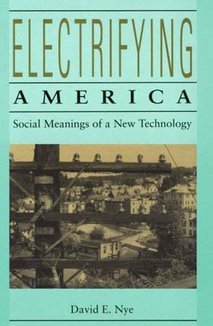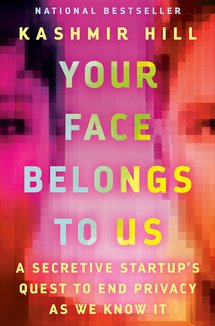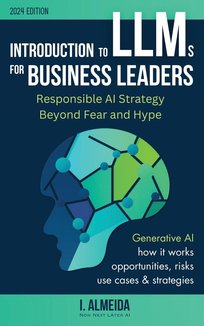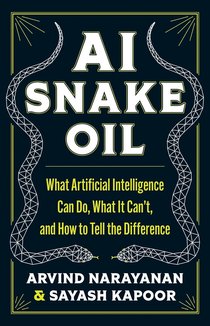Recommended Books

Electrifying America: Social Meanings of a New Technology, 1880-1940
Author:
David E. E. Nye
ISBN 13:
978-0262640305
How did electricity enter everyday life in America? Using Muncie, Indiana—the Lynds' now iconic Middletown—as a touchstone, David Nye explores how electricity seeped into and redefined American culture. With an eye for telling details from archival sources and a broad understanding of cultural and social history, he creates a thought-provoking panorama of a technology fundamental to modern life. Emphasizing the experiences of ordinary men and women rather than the lives of inventors and entrepreneurs, Nye treats electrification as a set of technical possibilities that were selectively adopted to create the streetcar suburb, the amusement park, the "Great White Way," the assembly line, the electrified home, and the industrialized farm. He shows how electricity touched every part of American life, how it became an extension of political ideologies, how it virtually created the image of the modern city, and how it even pervaded colloquial speech, confirming the values of high energy and speed that have become hallmarks of the twentieth century. He also pursues the social meaning of electrification as expressed in utopian ideas and exhibits at world's fairs, and explores the evocation of electrical landscapes in painting, literature, and photography. Electrifying America combines chronology and topicality to examine the major forms of light and power as they came into general use. It shows that in the city electrification promoted a more varied landscape and made possible new art forms and new consumption environments. In the factory, electricity permitted a complete redesign of the size and scale of operations, shifting power away from the shop floor to managers. Electrical appliances redefined domestic work and transformed the landscape of the home, while on the farm electricity laid the foundation for today's agribusiness.

Your Face Belongs to Us: A Secretive Startup's Quest to End Privacy as We Know It
Author:
Kashmir Hill
ISBN 13:
978-0593448564
NATIONAL BESTSELLER • The story of a small AI company that gave facial recognition to law enforcement, billionaires, and businesses, threatening to end privacy as we know it “The dystopian future portrayed in some science-fiction movies is already upon us. Kashmir Hill’s fascinating book brings home the scary implications of this new reality.”—John Carreyrou, author of Bad Blood A BEST BOOK OF THE YEAR: Financial Times, Los Angeles Times, Wired Winner of the Inc. Non-Obvious Book Award • Longlisted for the Financial Times and Schroders Business Book of the Year Award New York Times tech reporter Kashmir Hill was skeptical when she got a tip about a mysterious app called Clearview AI that claimed it could, with 99 percent accuracy, identify anyone based on just one snapshot of their face. The app could supposedly scan a face and, in just seconds, surface every detail of a person’s online life: their name, social media profiles, friends and family members, home address, and photos that they might not have even known existed. If it was everything it claimed to be, it would be the ultimate surveillance tool, and it would open the door to everything from stalking to totalitarian state control. Could it be true? In this riveting account, Hill tracks the improbable rise of Clearview AI, helmed by Hoan Ton-That, an Australian computer engineer, and Richard Schwartz, a former Rudy Giuliani advisor, and its astounding collection of billions of faces from the internet. The company was boosted by a cast of controversial characters, including conservative provocateur Charles C. Johnson and billionaire Donald Trump backer Peter Thiel—who all seemed eager to release this society-altering technology on the public. Google and Facebook decided that a tool to identify strangers was too radical to release, but Clearview forged ahead, sharing the app with private investors, pitching it to businesses, and offering it to thousands of law enforcement agencies around the world. Facial recognition technology has been quietly growing more powerful for decades. This technology has already been used in wrongful arrests in the United States. Unregulated, it could expand the reach of policing, as it has in China and Russia, to a terrifying, dystopian level. Your Face Belongs to Us is a gripping true story about the rise of a technological superpower and an urgent warning that, in the absence of vigilance and government regulation, Clearview AI is one of many new technologies that challenge what Supreme Court Justice Louis Brandeis once called “the right to be let alone.”

Introduction to LLMs for Business Leaders: Responsible AI Strategy Beyond Fear and Hype (Byte-sized Learning)
Author:
I. Almeida
ISBN 13:
978-0645510584
Find on:
 Amazon
Amazon

When Heaven Invades Earth: A Practical Guide to a Life of Miracles
Authors:
Bill Johnson
,
Jack Taylor
,
Randy Clark
ISBN 13:
978-0768429527
This book is a faith builder. It challenges every believer to walk in supernatural signs and wonders as a natural part of everyday life. ---John ArnottAnyone can walk in the miraculous---even you! If you've ever wanted to live and walk in the supernatural power of God, here's your chance!It is truly possible for human people to walk in the divine, and Christ came to show us the way. It is by rediscovering our true identity in Him that we can begin to move into the promises of God regarding the miraculous. Bill Johnson not only teaches the supernatural, he imparts it by changing the way we think.If you are not walking in the miraculous, you're living far below your birthright! By laying a carefully constructed biblical foundation for walking in the supernatural power of God, When Heaven Invades Earth provides all the equipment you need to experience miracles every day.
Find on:
 Amazon
Amazon

AI Snake Oil: What Artificial Intelligence Can Do, What It Can’t, and How to Tell the Difference
Authors:
Arvind Narayanan
,
Sayash Kapoor
ISBN 13:
978-0691249131
From two of TIME’ s 100 Most Influential People in AI, what you need to know about AI—and how to defend yourself against bogus AI claims and products Confused about AI and worried about what it means for your future and the future of the world? You’re not alone. AI is everywhere—and few things are surrounded by so much hype, misinformation, and misunderstanding. In AI Snake Oil , computer scientists Arvind Narayanan and Sayash Kapoor cut through the confusion to give you an essential understanding of how AI works and why it often doesn’t, where it might be useful or harmful, and when you should suspect that companies are using AI hype to sell AI snake oil—products that don’t work, and probably never will. While acknowledging the potential of some AI, such as ChatGPT, AI Snake Oil uncovers rampant misleading claims about the capabilities of AI and describes the serious harms AI is already causing in how it’s being built, marketed, and used in areas such as education, medicine, hiring, banking, insurance, and criminal justice. The book explains the crucial differences between types of AI, why organizations are falling for AI snake oil, why AI can’t fix social media, why AI isn’t an existential risk, and why we should be far more worried about what people will do with AI than about anything AI will do on its own. The book also warns of the dangers of a world where AI continues to be controlled by largely unaccountable big tech companies. By revealing AI’s limits and real risks, AI Snake Oil will help you make better decisions about whether and how to use AI at work and home.

The Software Engineer's Guidebook: Navigating senior, tech lead, and staff engineer positions at tech companies and startups
Author:
Gergely Orosz
ISBN 13:
978-9083381824
In my first few years as a developer I assumed that hard work was all I needed. Then I was passed over for a promotion and my manager couldn’t give me feedback on what areas to improve, so I could get to the senior engineer level. I was frustrated; even bitter: not as much about missing the promotion, but because of the lack of guidance. By the time I became a manager, I was determined to support engineers reporting to me with the kind of feedback and support I wish I would have gotten years earlier. And I did. While my team tripled over the next two years, people became visibly better engineers, and this progression was clear from performance reviews and promotions. This book is a summary of the advice I’ve given to software engineers over the years – and then some more. This book follows the structure of a “typical” career path for a software engineer , from starting out as a fresh-faced software developer, through being a role model senior/lead, all the way to the staff/principle/distinguished level. It summarizes what I’ve learned as a developer and how I’ve approached coaching engineers at different stages of their careers. We cover “soft” skills which become increasingly important as your seniority increases, and the “hard” parts of the job, like software engineering concepts and approaches which help you grow professionally. The names of levels and their expectations can – and do! – vary across companies. The higher “tier” a business is, the more tends to be expected of engineers, compared to lower tier places. For example, the “senior engineer” level has notoriously high expectations at Google (L5 level) and Meta (E5 level,) compared to lower-tier companies. If you work at a higher-tier business, it may be useful to read the chapters about higher levels, and not only the level you’re currently interested in. The book is composed of six standalone parts, each made up of several chapters: Part 1: Developer Career Fundamentals Part 2: The Competent Software Developer Part 3: The Well-Rounded Senior Engineer Part 4: The Pragmatic Tech Lead Part 5: Role Model Staff and Principal Engineers Part 6: Conclusion Parts 1 and 6 apply to all engineering levels, from entry-level software developer, to principal-and-above engineer. Parts 2, 3, 4, and 5 cover increasingly senior engineering levels and group together topics in chapters, such as “Software Engineering,” “Collaboration,” “Getting Things Done,” etc. Naming and levels vary, but the principles of what makes a great engineer who is impactful at the individual, team, and organizational levels, are remarkably constant. No matter where you are in your career, I hope this book provides a fresh perspective and new ideas on how to grow as an engineer. Praise for the book “From performance reviews to P95 latency, from team dynamics to testing, Gergely demystifies all aspects of a software career. This book is well named: it really does feel like the missing guidebook for the whole industry.” – Tanya Reilly, senior principal engineer and author of The Staff Engineer's Path "Spanning a huge range of topics from technical to social in a concise manner, this belongs on the desk of any software engineer looking to grow their impact and their career. You'll reach for it again and again for sage advice in any situation." – James Stanier, Director of Engineering at Shopify, author of TheEngineeringManager.com
Find on:
 Amazon
Amazon